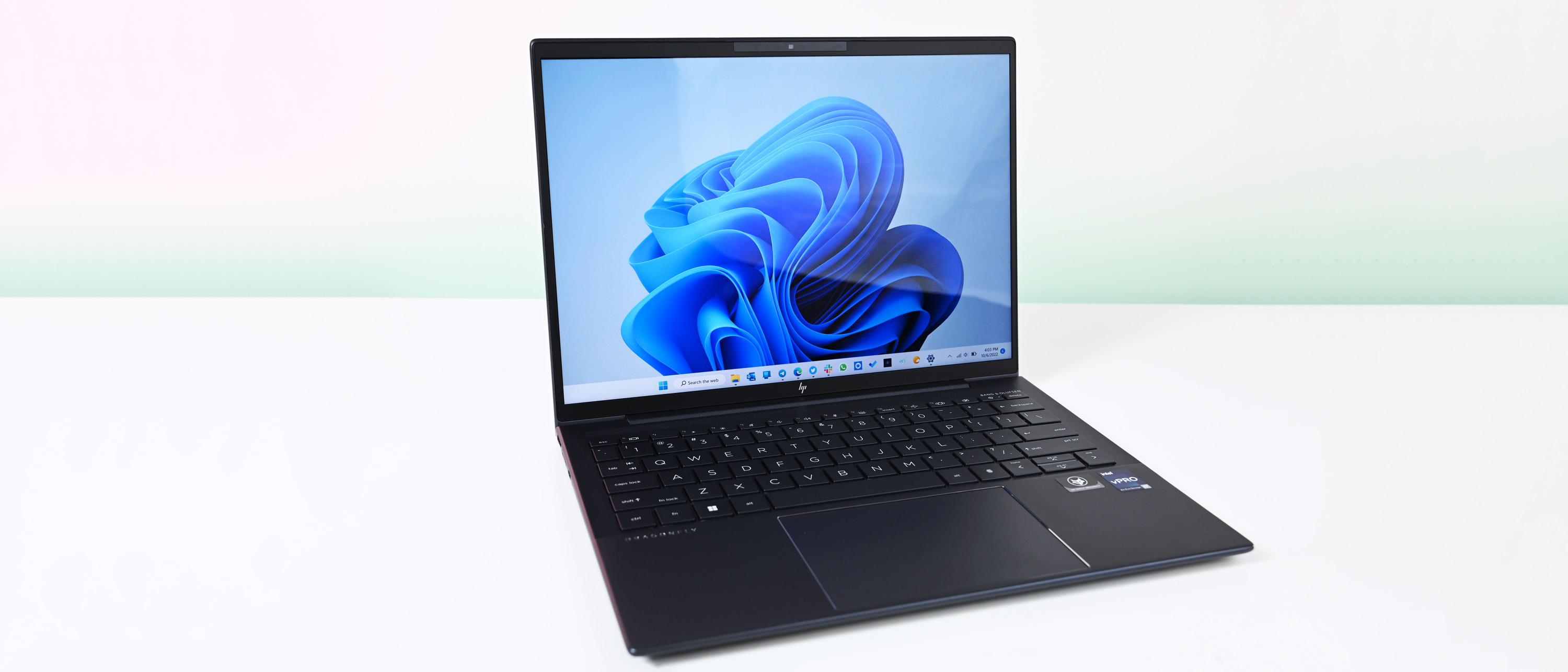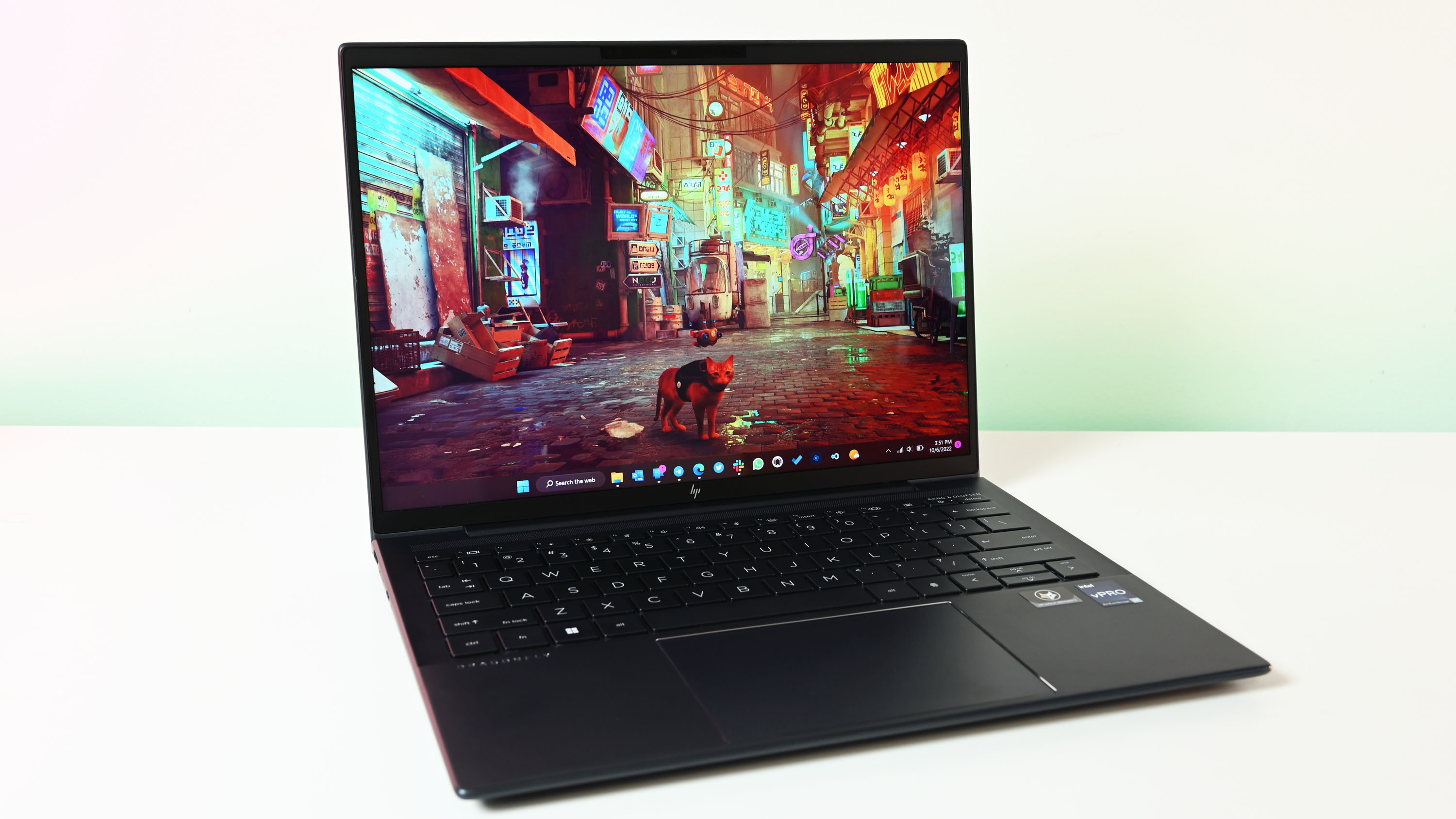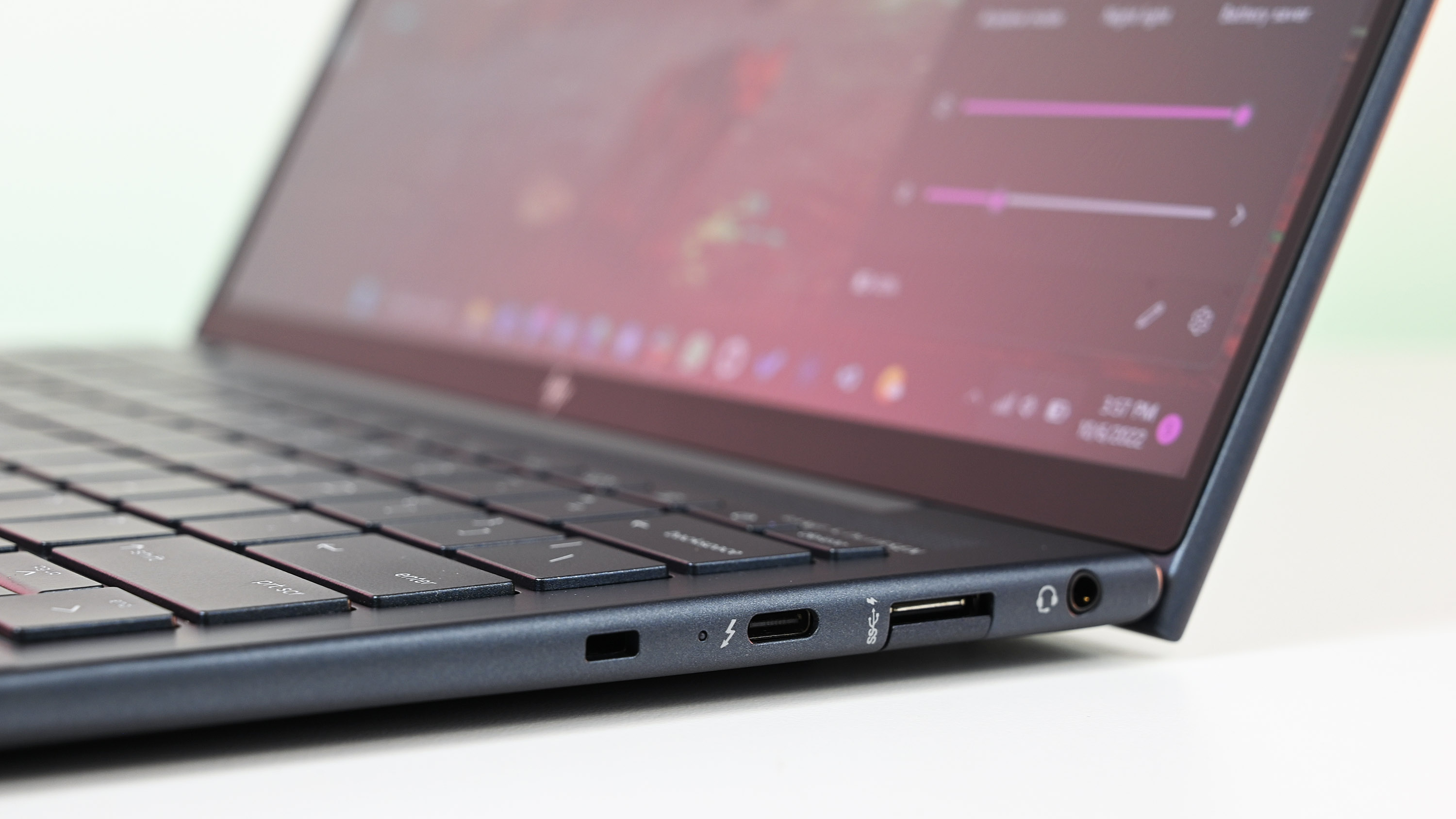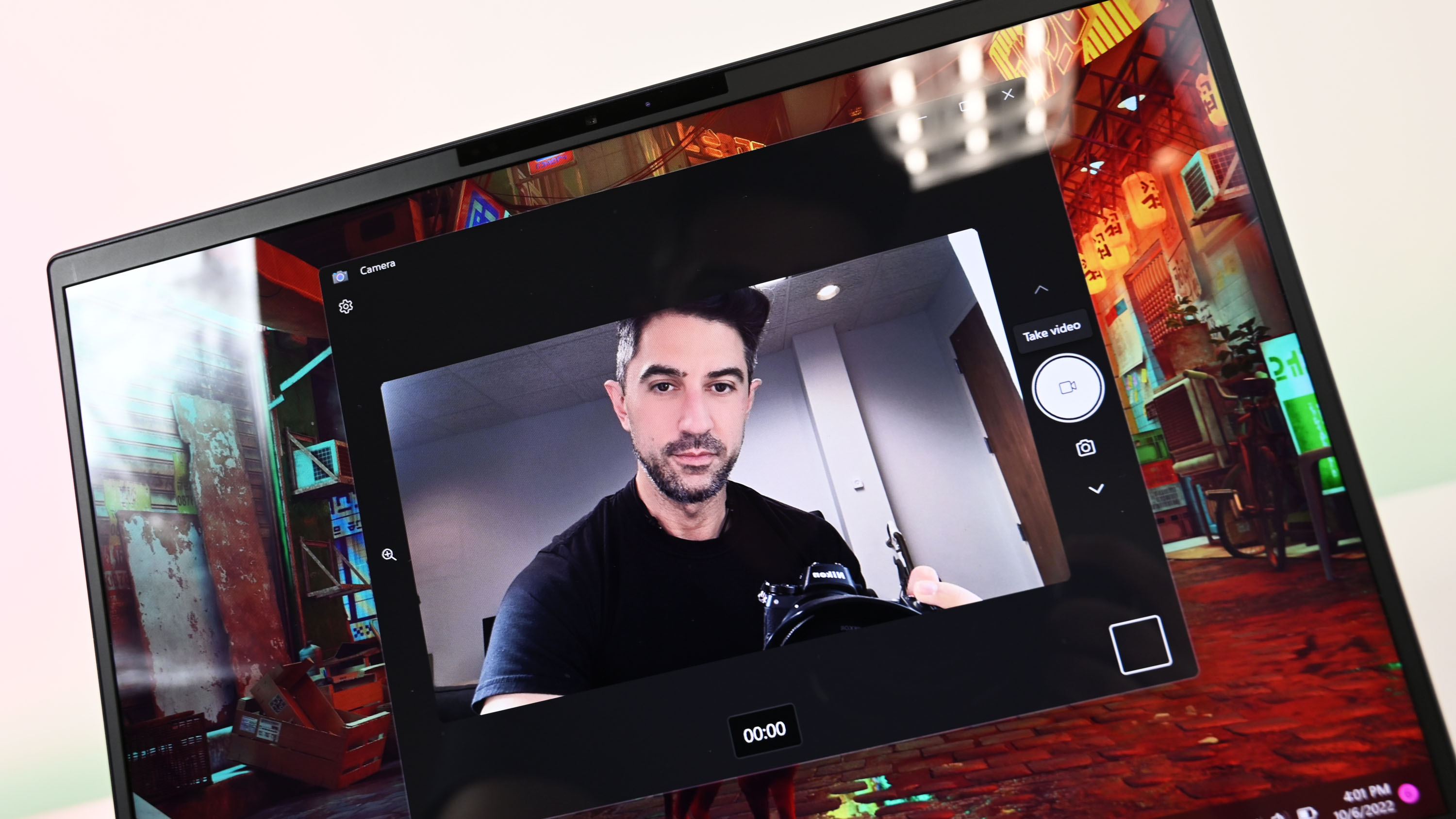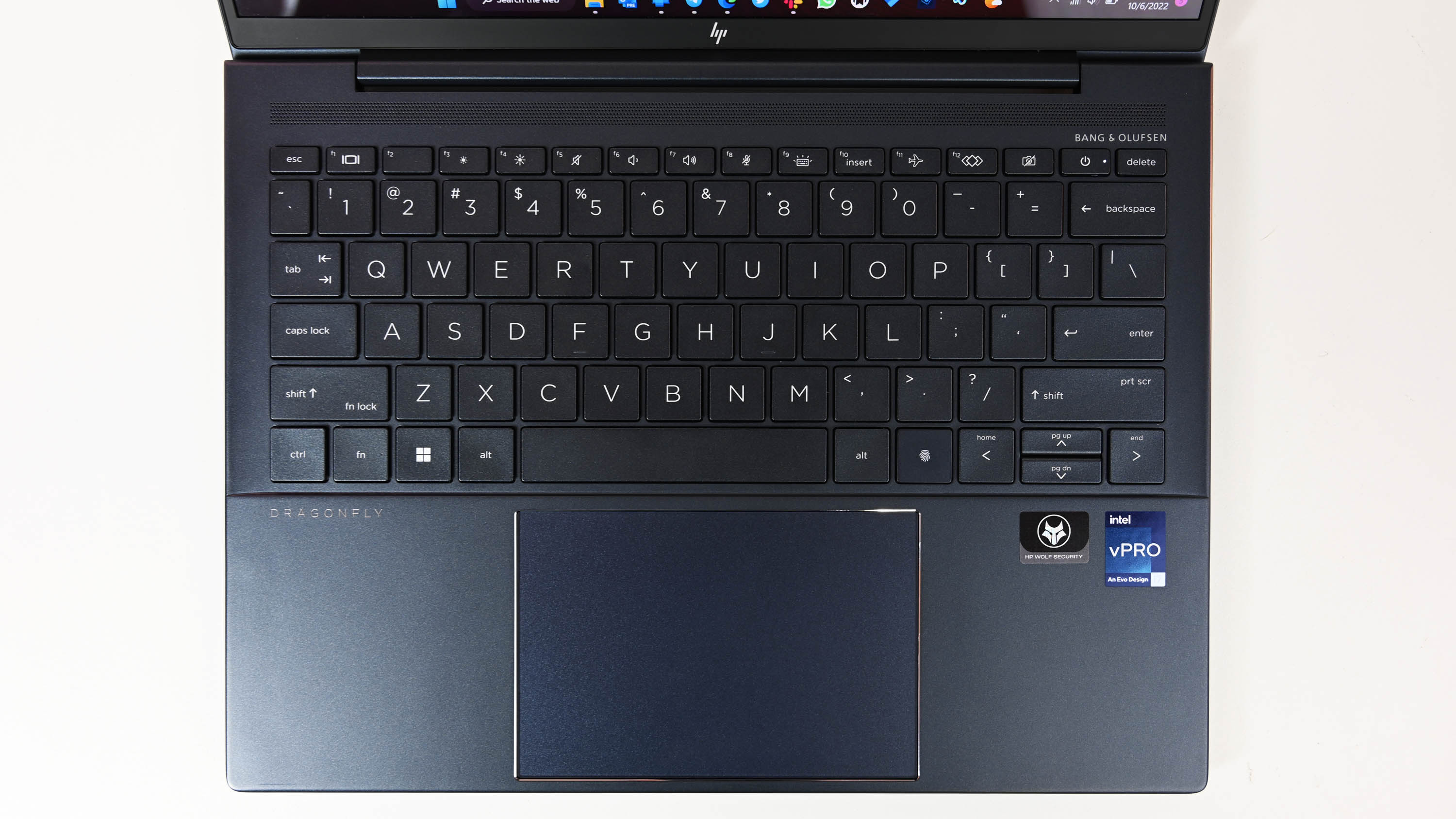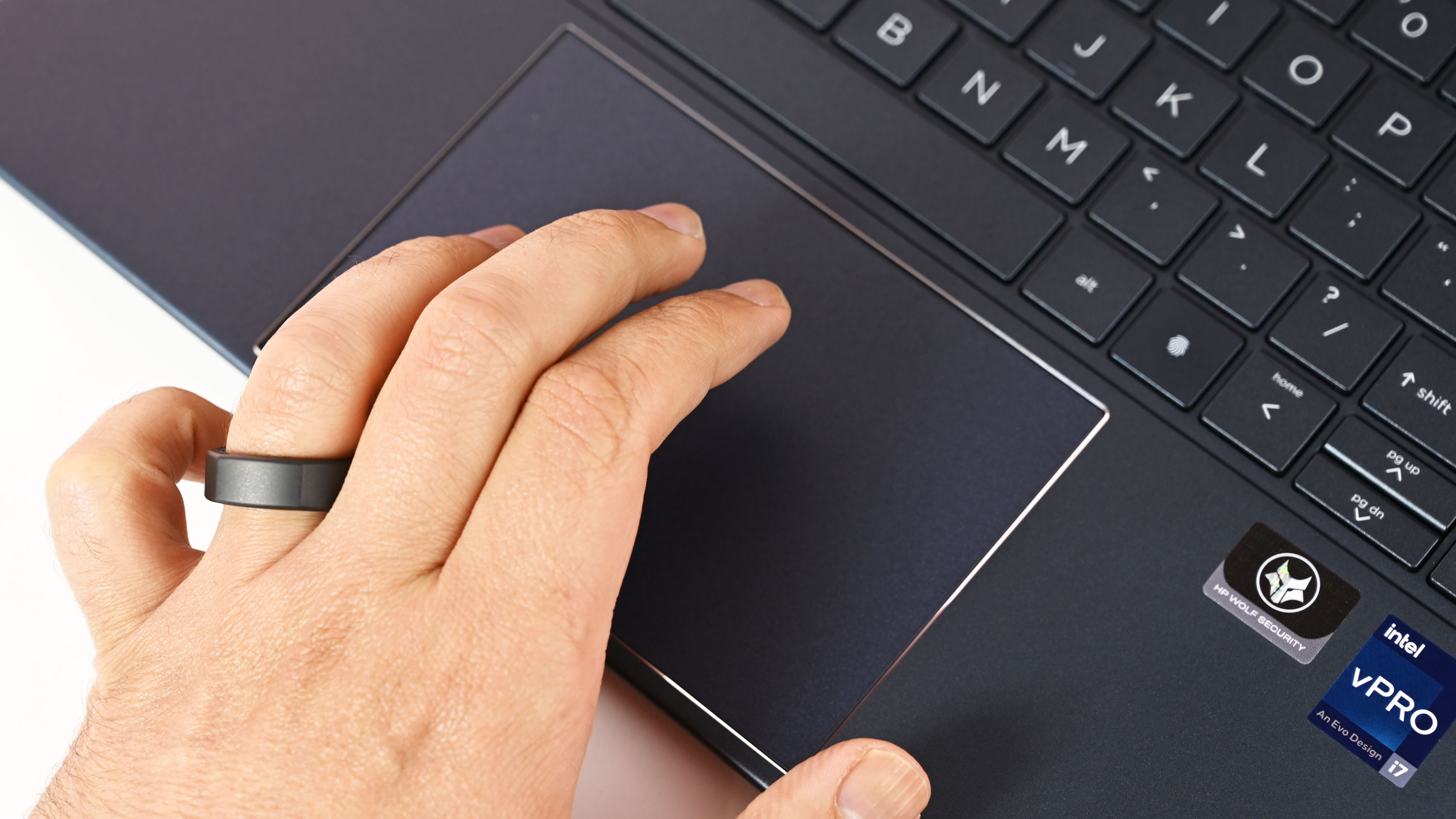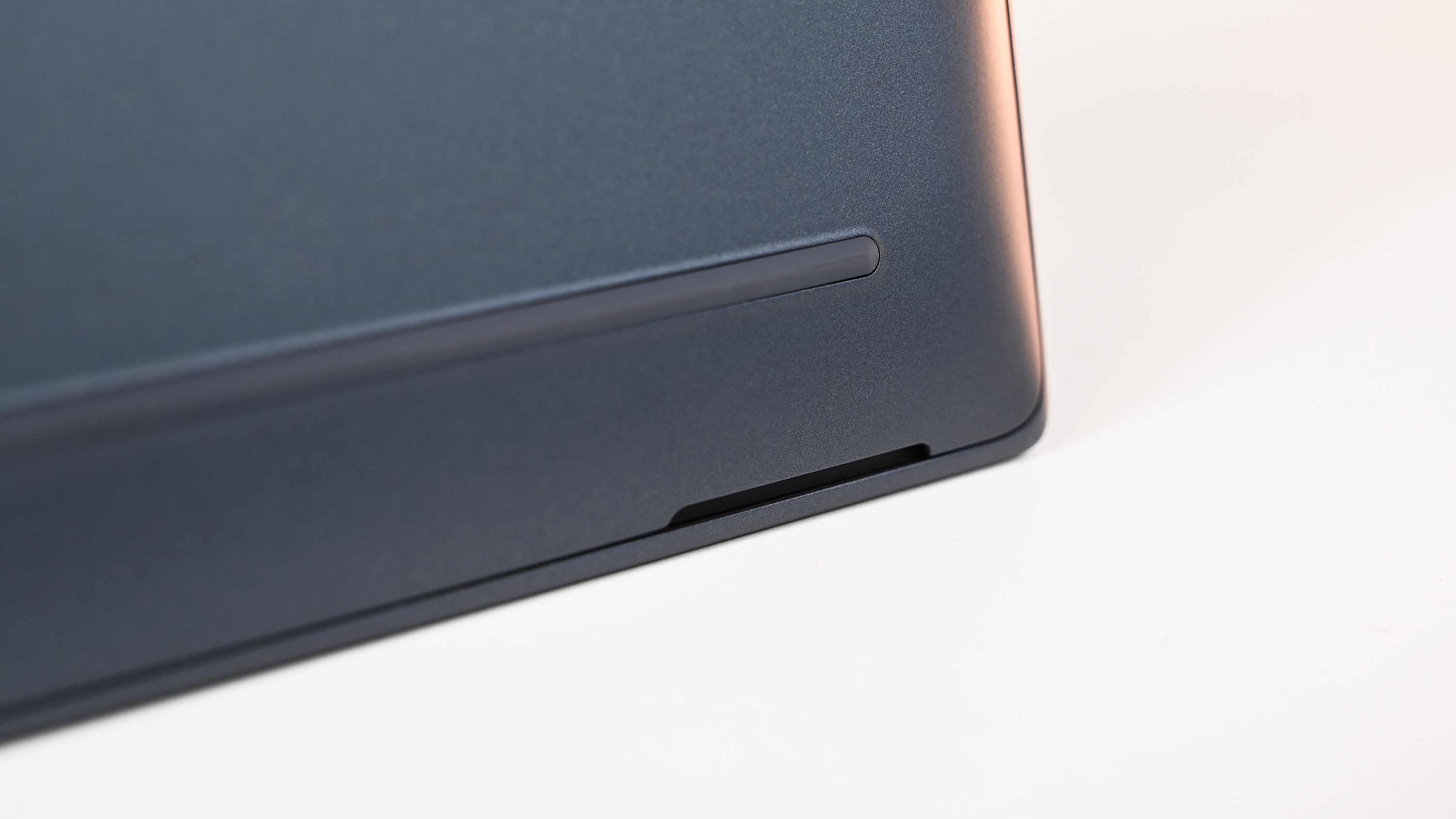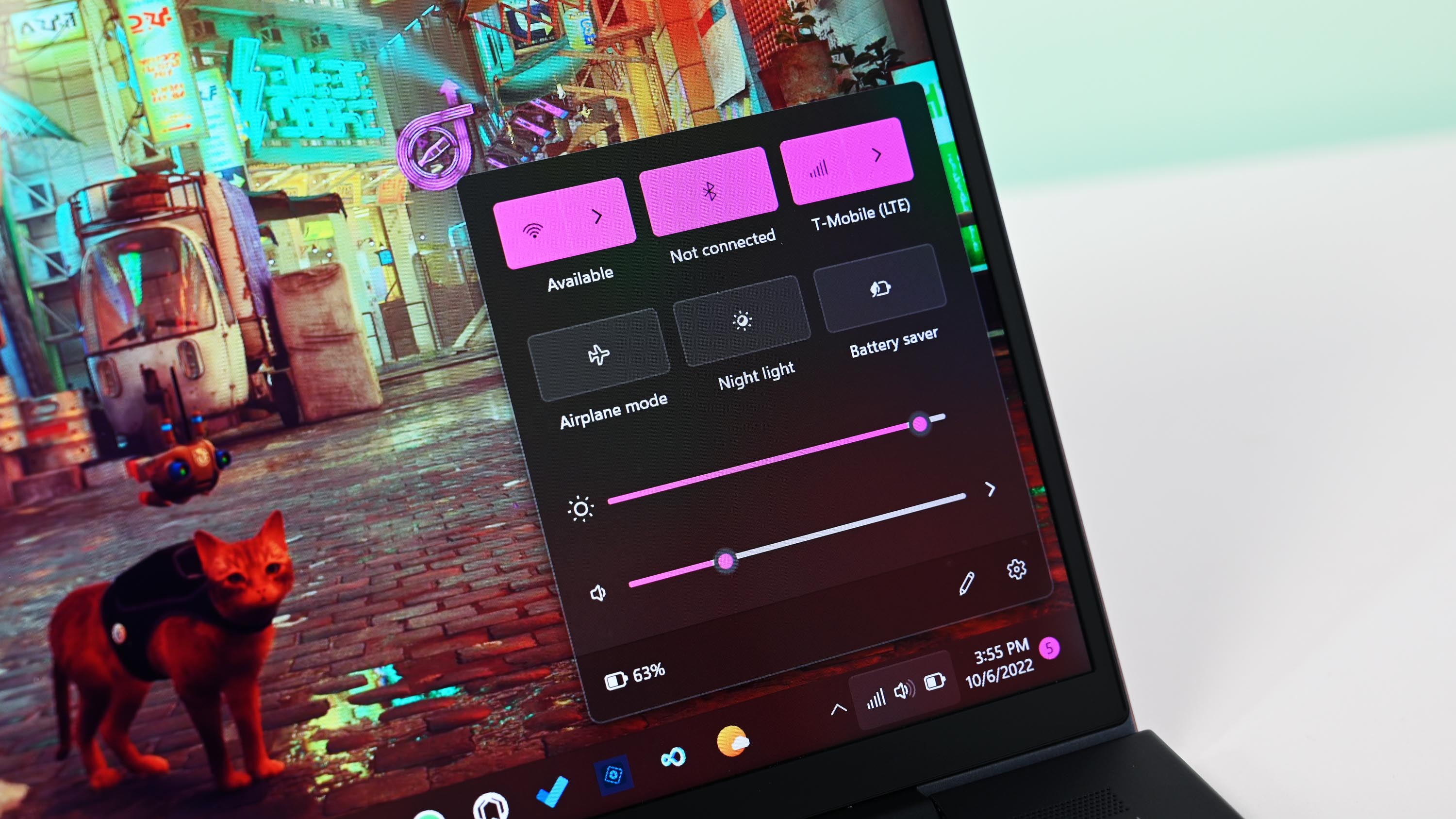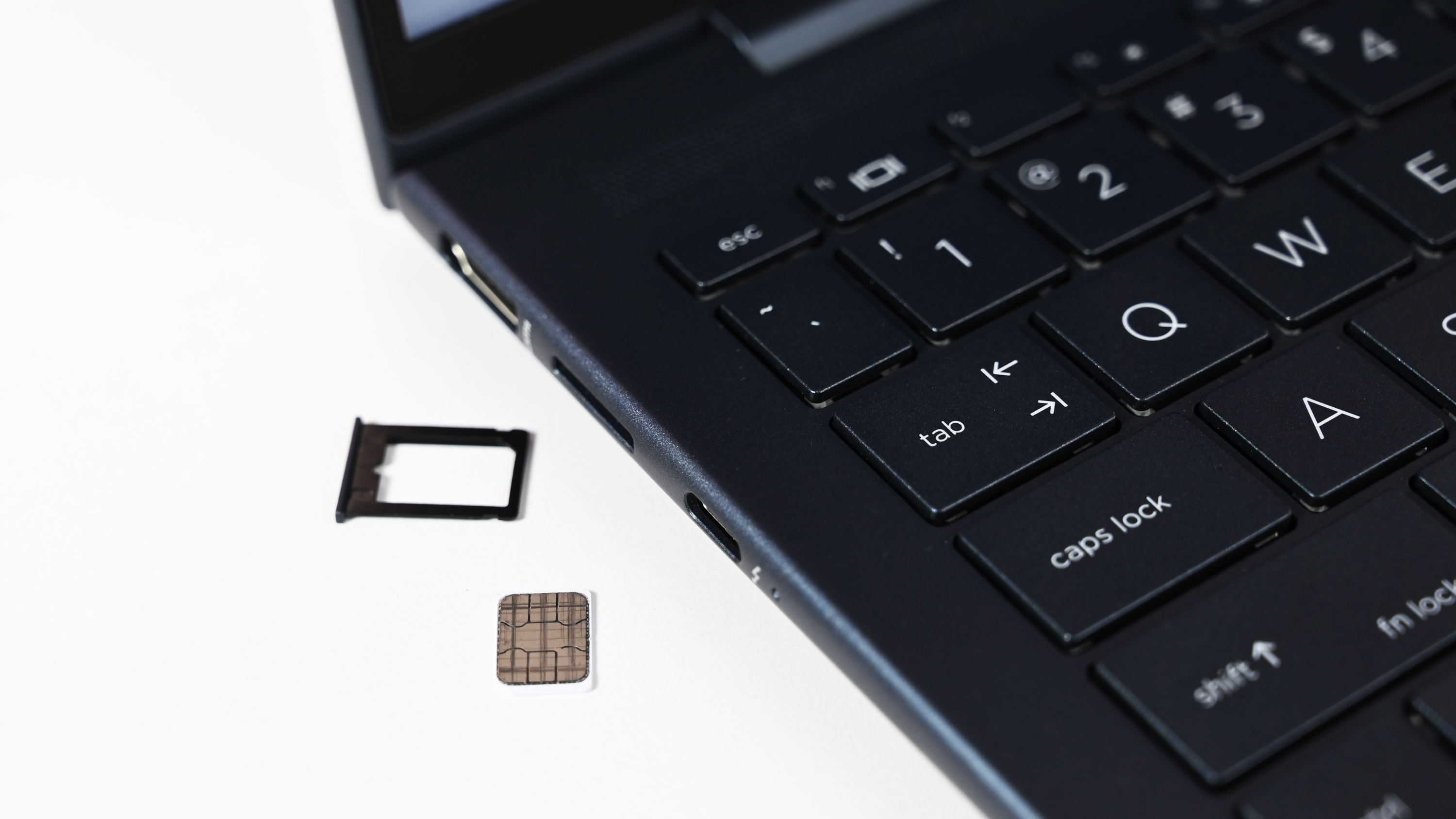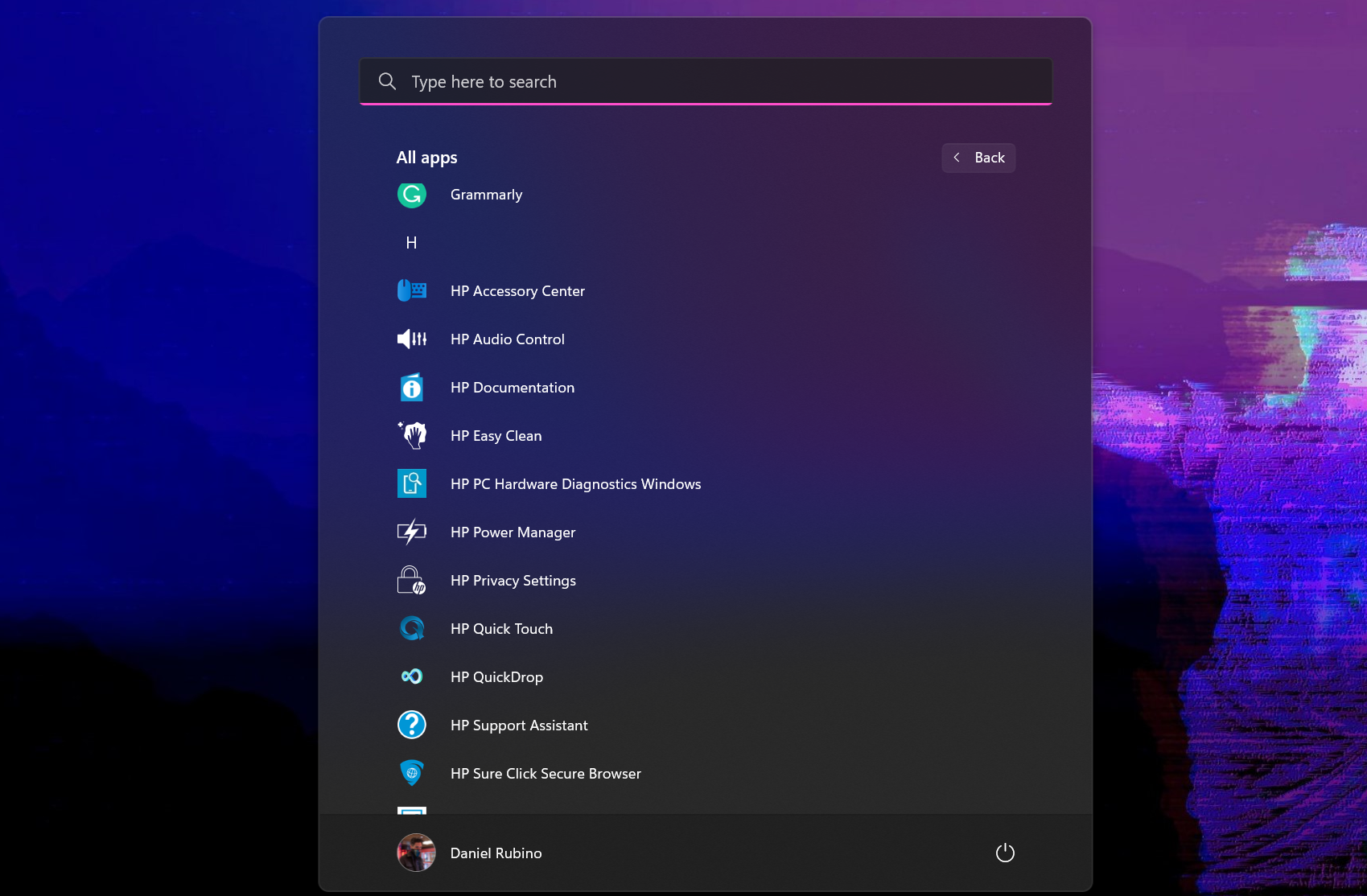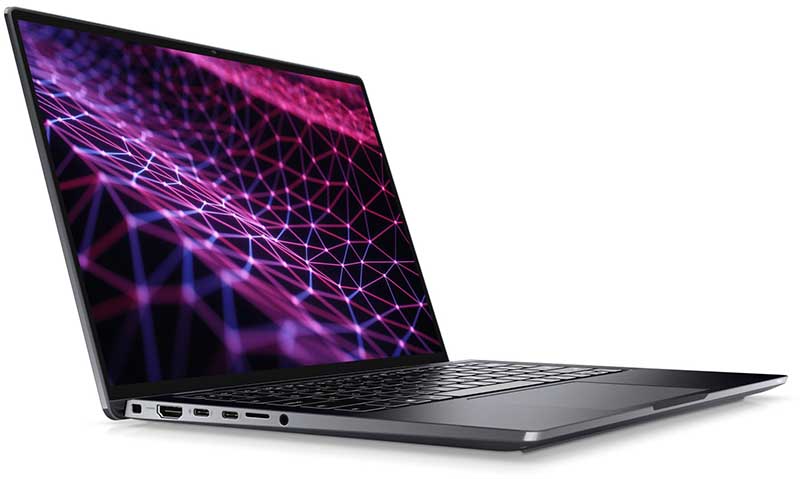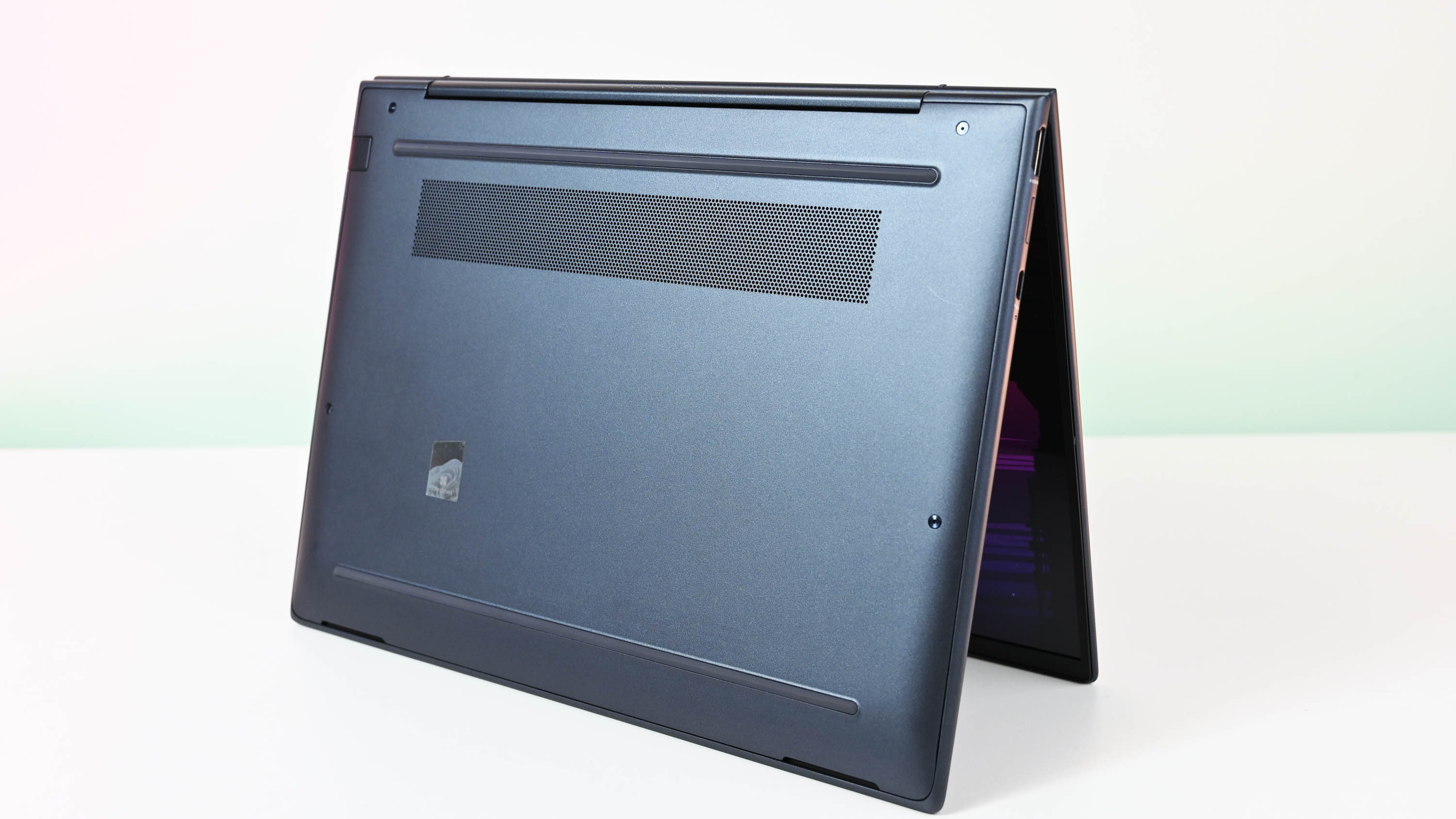Windows Central Verdict
Weighing just 2.2lbs, the HP Elite Dragonfly G3 has everything we want in a pro-level business laptop. Excellent speakers, 5MP front cam, good performance, excellent keyboard and touchpad, and a tall 3:2 display. Get the optional 5G for even more mobility.
Pros
- +
Weighs just 2.2lbs (0.99kg)
- +
Excellent build quality
- +
Fantastic full HD 5MP camera
- +
Very good quad-speakers
- +
Great typing and touchpad experience
- +
Optional 4G LTE/5G
Cons
- -
Can be expensive if not on sale
- -
3:2 aspect may be too tall for some
- -
Should ship with a 2-pronged charger
- -
Battery life could always be better
Why you can trust Windows Central
I’ve used many laptops over the years, and a few stick out from the bunch. Some are HP EliteBooks, others Lenovo ThinkPads, and a few Surface Pros and Surface Laptop Studios come to mind.
The HP Elite Dragonfly G3 (with optional 5G) is one of those laptops. I’ve used it for the last eight weeks for personal use and extensive travel, e.g., my Israel trip with Intel. When first announced back at CES 2022, I thought it was a strange departure from the previous Elite Dragonfly models (more on that below). But after using it, I now get what HP is going for: A super light, long-lasting, ultra-mobile laptop that delivers in all the primary areas.
So, while I know the Elite Dragonfly G3 may be priced out of range for your average user, you can’t go wrong for the executive who wants the best Windows 11 laptop for work. Here’s why.
HP Elite Dragonfly G3: Price, availability, and specs
Like many business laptops from HP, there are pre-configured models of the Elite Dragonfly G3 and the ability to customize it based on display, processor, and connectivity preferences (not to mention controlling for price).
The base unit starts at $1,394 (discounted) and comes with a 12th Gen Core i5 U-series processor, WUXGA+ touch display, 16GB RAM, and 512GB storage. In addition, it has Windows 10 Pro on board as a downgrade from Windows 11 Pro, which is vital for some orgs.
| Category | HP Elite Dragonfly G3 |
|---|---|
| Display | 13.5-inch 3:2 WUXGA (1920x1280) or 3K2K OLED (400 nits) |
| Processor | Intel 12th Gen Intel vPRO, Intel Evo |
| Graphics | Intel |
| Memory | Up to 32GB LPDDR5 (soldered) |
| Storage | Up to 2TB PCIe SSD |
| Front Camera | 5MP (separate RGB and IR sensors) with HP Sure Shutter |
| Security | Windows Hello IR and fingerprint |
| Connectivity | Wi-Fi 6E Bluetooth 5.2 Optional: 4G LTE, 5G, NFC, Tile |
| Ports | 1x USB-A 3.1 (charging port) 2x USB-C (Thunderbolt 4) HDMI 2.0 Nano SIM slot Combo Headphone/Mic |
| Audio | Quad speakers with discrete amplifiers |
| Battery | HP Long Life 4-cell 45WHr and 6-cell 68WHr Fast Charge Up to 100W Type-C charger |
| Dimensions | 297.4 x 220.4 x 16.4 mm (16.9mm in AG) 11.71 x 8.68 x .65 in (.35 in AG) |
| Weight | Starting at 2.20 lbs. / .99 kg (Weight will vary by configuration) |
| Colors | Slate blue or Natural Silver Hybrid Mg/Al |
If you max out the Elite Dragonfly G3, you get 32GB of RAM, Core i7-1265U, Anti-Glare WLED UWVA WUXGA+ (1920x1280) Touchscreen, 1000 nits, with Sure View Reflect Privacy, 1TB storage, Intel 5G, and NFC for a hefty $2,971.50 $2,122 (HP is now running some excellent sales on it).
For those who want a higher resolution, premium display, there is the ability to configure the Elite Dragonfly G3 with an OLED UWVA 3k2k (3000x2000) Touchscreen.
All the latest news, reviews, and guides for Windows and Xbox diehards.
The cheapest 5G option uses a Core i5 and 16GB of RAM for $2,000.
Our review unit has a Core i7-1265U vPro, 16GB of RAM, 512GB of storage, Intel 5G, and a BrightView WLED UWVA WUXGA+ (1920x1280) non-touch display, which comes in just under $2,500 ($1,769 discounted).
HP Elite Dragonfly G3: Design and ports
The Elite Dragonfly series from HP is a cross between its premium consumer laptops (Spectre) and its business-class PCs (EliteBooks). It’s all the bells and whistles with the latest tech available. However, it also focuses on being as light as possible, hence the price tag.
Coming in at just 2.2 lbs (< 1kg), the Elite Dragonfly G3 is so light it feels hollow. Some will mistake this for feeling cheap, but criticisms go away once you start using the laptop. The laptop is also thin, but it’s not going for any records, as having a sizeable 68WHr battery is more important. Good choice, HP. It being lightweight is one reason I keep picking it for my travels.
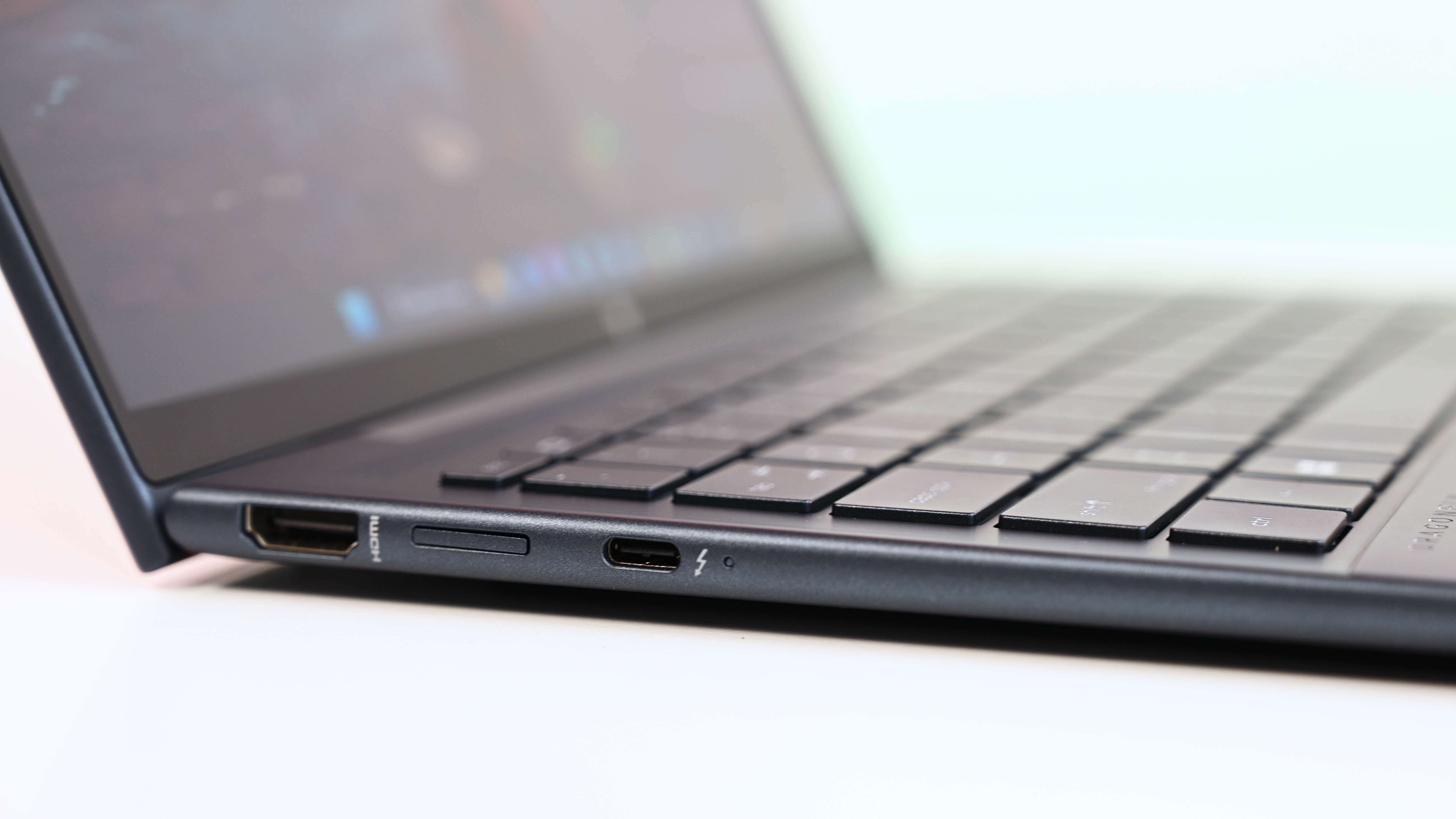
The build quality is outstanding, and the Slate Blue colorway in this review unit is a muted grayish blue that adds a bit of flair while remaining professional. Overall, it’s a clean and minimal design, and HP’s mirror logo adds some panache.
The port selection will make any PC user envious. For one, there’s a full HDMI port, which is rare nowadays in a laptop this size. HP also has its drop-jaw USB-A port for thumb drives. There are also two Type-C Thunderbolt 4 ports with one on each side, aka the correct way to do Type-C ports, as it gives the user more latitude when charging or using peripherals.
Finally, there’s a headphone jack on the right side and on the left, the SIM slot, which doesn’t require a tool to open (you press in, and it pops out). This is perfect for the road warrior who hates dongles and adapters.
HP Elite Dragonfly G3: Display and webcam
Changing it up this year, the Elite Dragonfly G3’s 13.5-inch display goes from 16:9 to 3:2 – the same aspect as Surface Laptops. Few laptops use 3:2 as it’s narrower and taller than the more common 16:10. But I like HP’s choice here as you see much more information in an Excel sheet or Word document.
The full HD display is sharp (despite being on the low end for resolution) and a joy to work on. The tradeoff with full HD is a better price and longer battery life.
Out of the box, the screen gets 98% sRGB, 74% AdobeRGB, and 78% DCI-P3 for the color gamut, but it can be calibrated to 100% sRGB. That’s fine for photo editing, and colors look good, especially if you enable the Adaptive Color sensor, which changes the display’s color based on ambient lighting conditions.
HP BrightView also means the screen is glossy, but HP offers an anti-glare option, so you can’t complain. Brightness peaks at 407 nits, just above the quoted 400 nits by HP.
HP’s 5MP front-facing camera (with separated RGB and IR sensors) is marvelous. Excellent software can auto-frame, enhance lighting, blur your background, and use filters to improve your appearance (skin smoothing). It’s easily one of the best webcams I have ever used, rivaled only by the HP Dragonfly Folio G3, which has a massive 8MP front camera, and the new Surface Pro 9 5G (ARM). There is also noise reduction, which works well enough.
For security, HP has its privacy shutter for the webcam, which is enabled by a dedicated keyboard button. Tap it, and a little internal shutter covers the lens. Only HP offers this feature, and it’s so good. There is also a dedicated key to mute your microphone with an LED to let you know it’s enabled. Logging into Windows can be accomplished via face recognition or the fingerprint reader, which is ideal if you leave the privacy shutter enabled all the time. HP’s Wolf Security functions also offer enhanced malware protection for software and web browsing.
HP Elite Dragonfly G3: Keyboard, touchpad, audio
The keyboard and touchpad on the Elite Dragonfly G3 are also the best I have used. The keyboard is a bit softer (mushier) than HP’s standard EliteBooks, but I also didn’t suffer hand fatigue from typing for long durations. It’s one of those keyboards you get used to immediately, but it feels odd at first.
The touchpad is massive, and despite not being haptic, it is deadly accurate, smooth, and has an enjoyable soft click when pressed. Around the trackpad is just a hint of chrome chamfer, which is gorgeous when it catches the light.
Audio is rich and handled by four B&O-tuned speakers, each with discrete amps. Two are on top of the laptop, while the other two are on the bottom front, where the laptop curves slightly, giving some clearance. These are outstanding speakers, and the Audio Playbook Tools software with a 10-band equalizer and HP Dynamic Audio (auto, music, movie, or voice) lets you tune it to your liking.
HP Elite Dragonfly G3: 4G LTE and 5G
The combo 4G and 5G Intel modem worked flawlessly. Drop in a physical SIM, and this laptop is good on all networks. Don’t have a SIM or are traveling? Use the eSIM function as I did in Israel. Getting off the plane and having this laptop instantly connected with 4G data is tremendous, allowing me to work anywhere on the Intel tour.
I never had any issues with reception or performance.
HP gets some credit for not needing a SIM tool, either. Instead, the slot is on the left side, and you push in to eject the SIM tray, add the SIM, and push it back into place.
HP Elite Dragonfly G3: Performance and battery life

In our benchmark results, the Dragonfly hardly blows away the competition, but performance is better than the raw processor speed: It’s the sum of the components that matter. While the Intel 12th Gen Core i7-1265U is not the fastest I have used, thanks to the ten cores, it is still darn fast and responsive. I never had issues using Adobe Photoshop Elements or doing other "information worker" type tasks like web, email, heavy browser usage, Microsoft Office, Slack, etc.
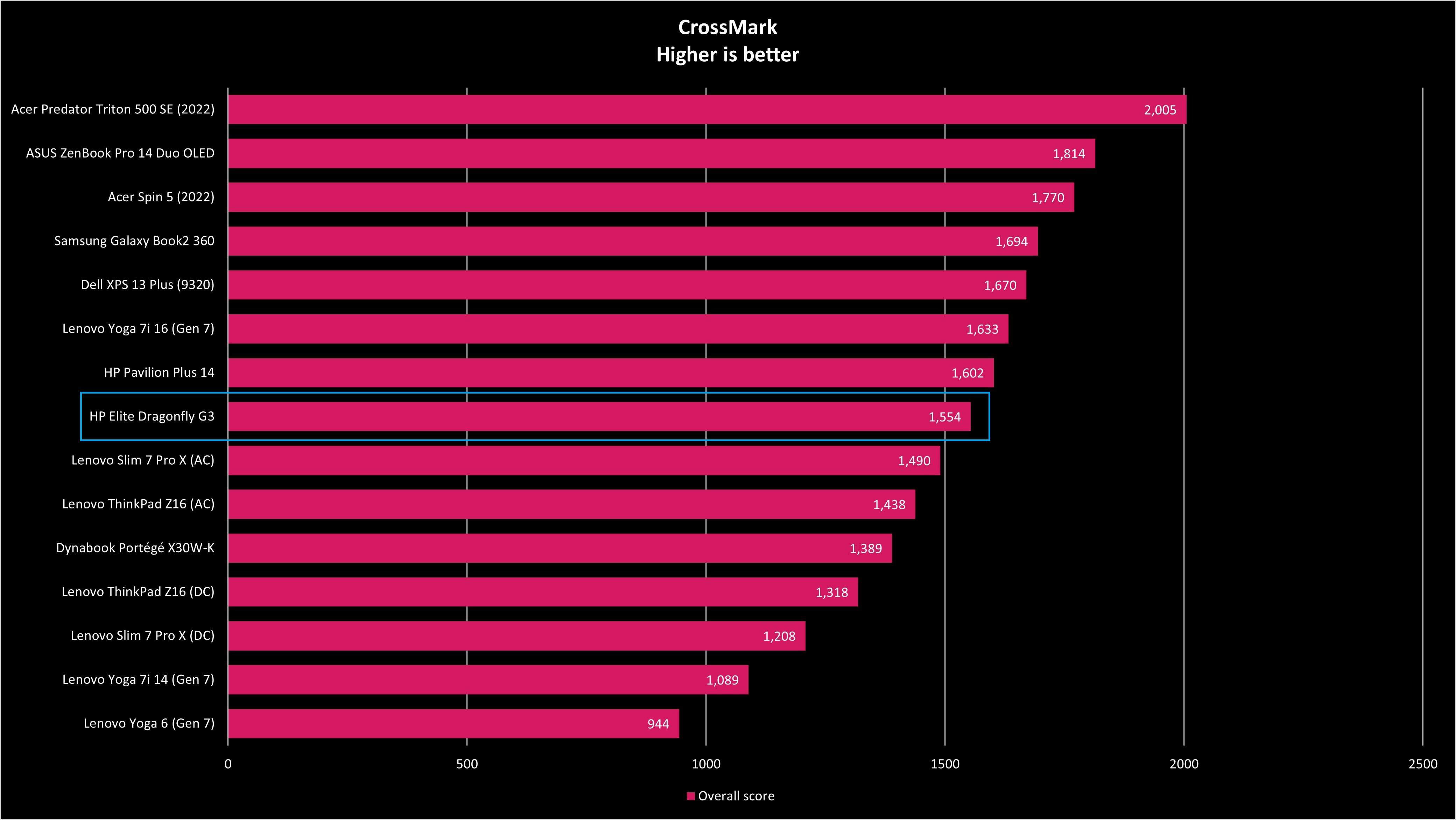
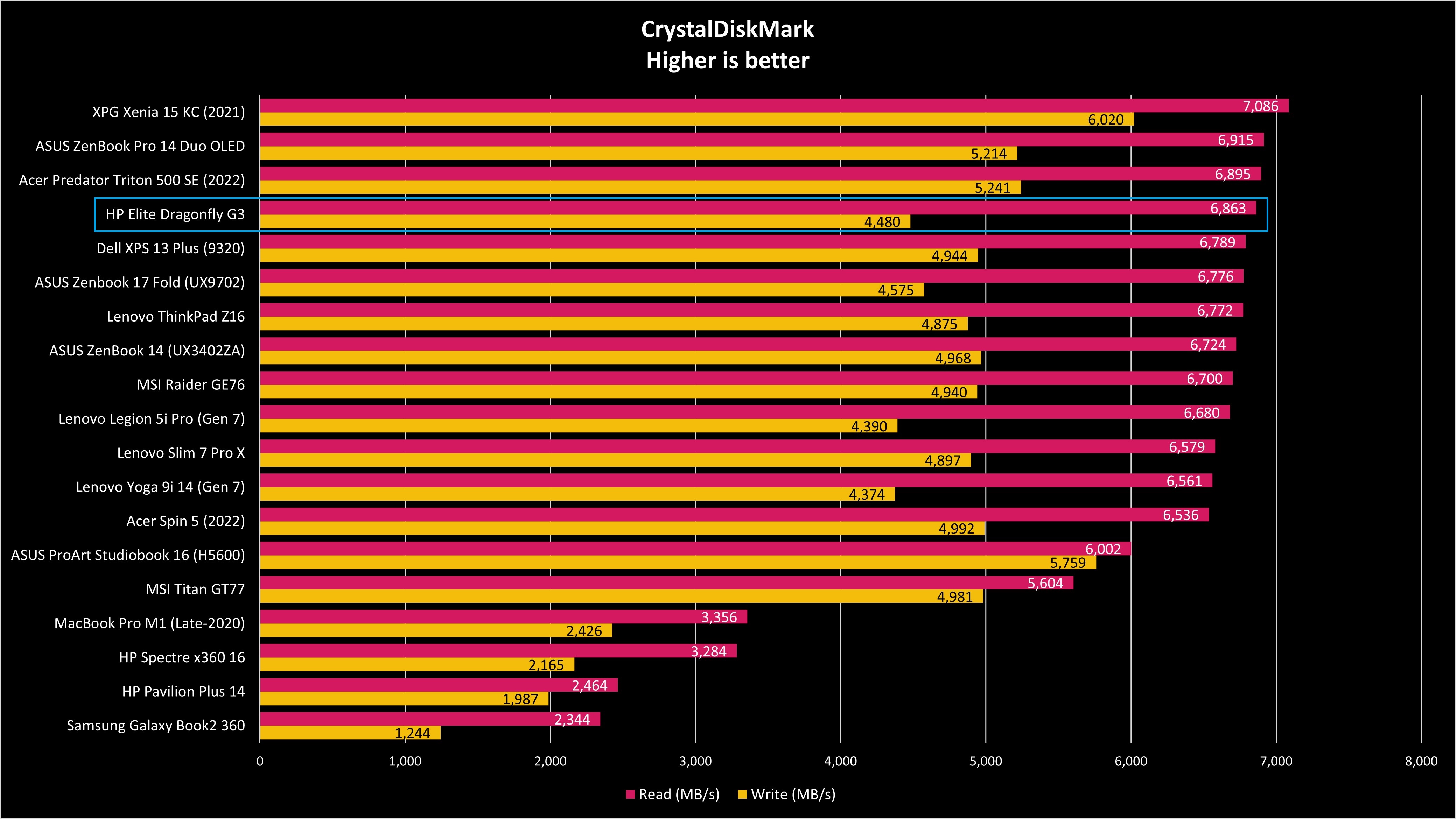
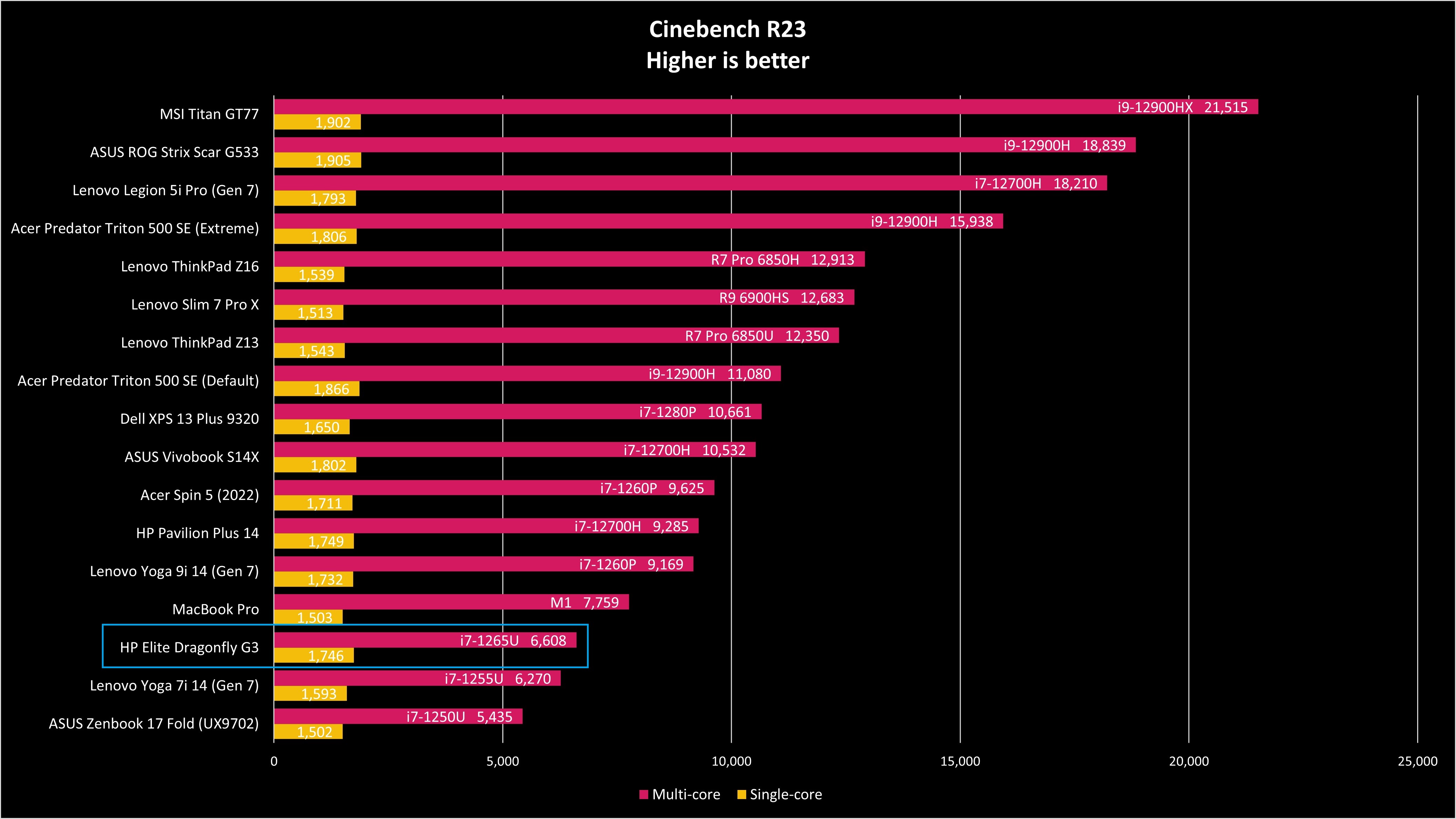
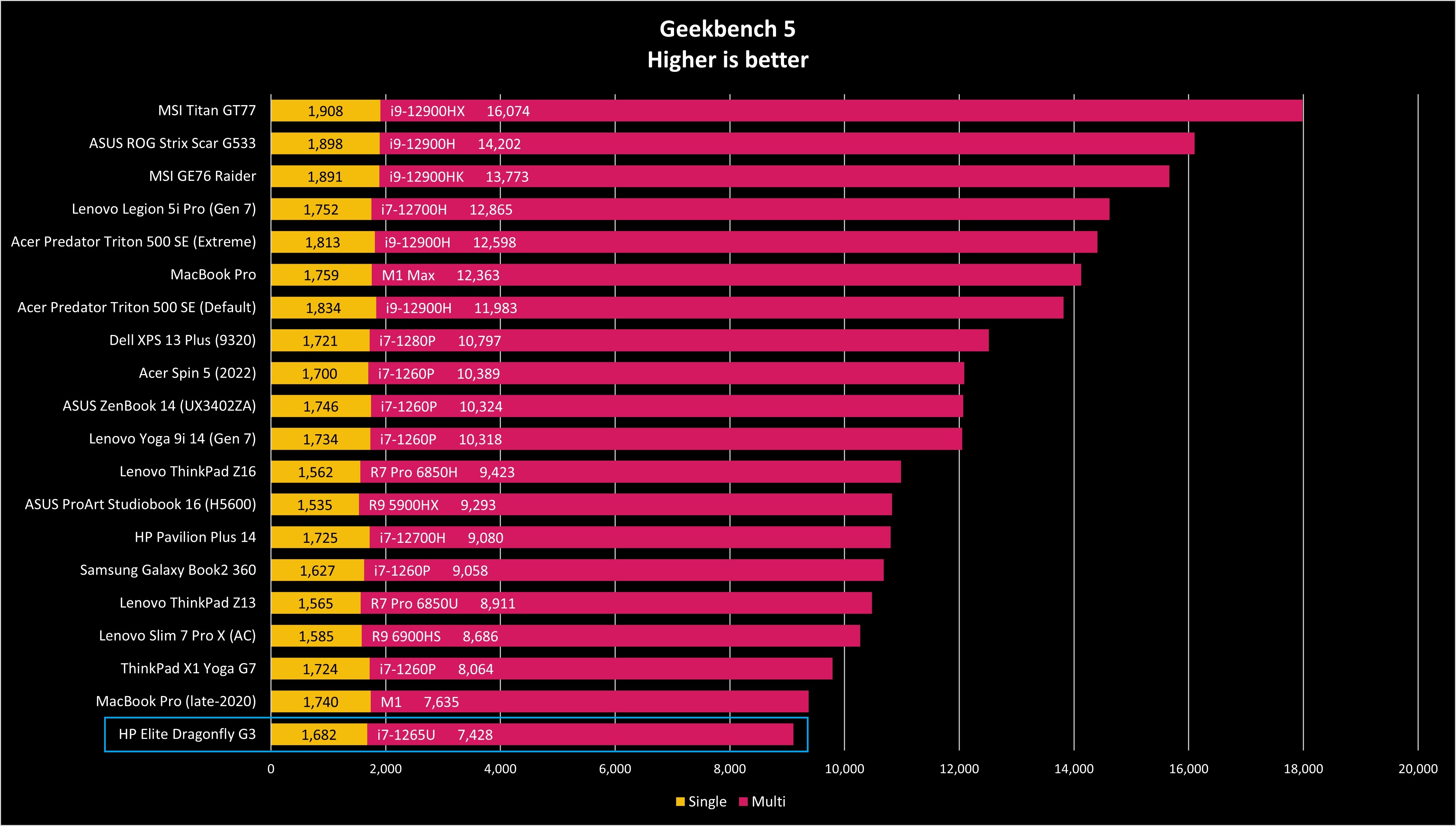


With the i7 tuned to more modest speeds, the cooling and fan deliver a more amicable and quieter experience. The laptop never got hot and always stayed cool during regular usage.
The 512GB PCIe 4.0 SSD is also insanely fast at 6,863 MB/s for read and 4,480 for write, making it one of the fastest I have used.
Toss is zippy LPDDR5 RAM, and this laptop rivals the Dell XPS 13 Plus on PCMark 10 (which measures overall system performance). Dell’s premium laptop uses a much beefier Core i7-1280P processor, which is noteworthy here as context is everything.
Battery life is decent, lasting between 7 and 8 hours of real-world usage over a few months. Unfortunately, Intel 12th Generation Mobile Processors are not great on battery life, but in exchange, you get excellent performance, especially compared to its 11th generation predecessor. For these reasons, HP was wise to use a U-series chip instead of the more power-hungry P-series.
HP Elite Dragonfly G3: Software and extra features
I said this laptop has all the bells and whistles, including human presence detection (HPD), Tile, and HP QuickDrop.
When HPD is enabled, the Elite Dragonfly G3 can automatically lock your laptop if you step away from it for 30 seconds or more. When you return, the display will automatically turn on, and Windows Hello will log you back where you left off.
Moreover, it can detect if someone is peaking over your shoulder and alert you to their presence. Wild stuff.
Tile is a free device locator that is built into the motherboard. Again, only HP offers this, which means you can track your laptop on the map using the phone app. Sign up for the premium service, and your phone alerts you if you leave your computer behind.
You can add Tile to any device (bag, wallet, keys) thanks to its “tags” that you can buy, but having it built-in to your laptop is priceless. Moreover, it works independently of the laptop, meaning if the PC is in Airplane Mode, it still works.
QuickDrop is an app that runs on the PC and your phone (iOS or Android). It lets you send photos, documents, or text between your devices. It can even handle SMS messages. While Microsoft’s Phone Link does much of the same, HP’s QuickDrop uses Wi-Fi Direct and is simply faster (plus it’s pretty cute).
HP even includes an app called HP Easy Clean. Run it, and it turns off the keyboard and touchpad for two-and-a-half minutes, letting you wipe down, clean, and disinfect your laptop without having to power down. It's such a small thing, but I find this app incredibly useful, especially if you want to keep your laptop pristine.
HP Elite Dragonfly G3: Cons
Honestly, there’s nothing if I don’t want to be nitpicky.
The Elite Dragonfly G3 is expensive, but HP often runs sales, bringing the price down. Plus, this laptop is for the C-suite, not regular consumers hitting Best Buy. Big companies have the budget for their executives, and HP knows this.
While the touchpad is one of the best, I think a haptic one would be even cooler. Ironically, HP uses one in its Dragonfly Chromebook, so I’m not sure why it didn’t here.
Being an x86 Intel-based laptop, I’d never say more to added battery life or even quieter fans, but I think HP maxed out what it could achieve with today’s technology and design goals.
The matte plastic bezel looks a bit cheap. HP avoided a seamless glass experience to keep the weight down, but a bit of gloss wouldn’t hurt here.
I also don’t get why the fingerprint reader is a dedicated key that depresses instead of just a reader in the deck. It works the same, but it is a bit weird.
Finally, this is just a general HP complaint, but for a laptop aimed at the mobile professional, I find it odd that HP ships its laptops with a three-pronged 65W charger. It's a gorgeous, tiny charger with a corded rope design, but if you have flown before, you know that finding a three-pronged AC outlet on a plane is very rare. By contrast, Lenovo ships its ThinkPads with a 65W two-pronged charger, and I wish HP would do the same. (As a result, I use a Lenovo charger for HP when I fly, but HP prefers HP-branded chargers, which it notifies you of when you plug it in).
Do any of these “complaints” matter? Not for me, as they’re just weird design quibbling, but I had to put something in this section.
HP Elite Dragonfly G3: Competition
There is a lot of competition for the Dragonfly G3 if you factor in all premium laptops in the 13- to 14-inch range. But that list dwindles if you count 4G and 5G as a requirement and a focus on enterprise security and features.
Lenovo’s ThinkPad X1 Carbon ticks many boxes with options for 5G, and it certainly fits the business-laptop designation. It’s an excellent device that is often regarded as the top business laptop due to the legacy of Lenovo. However, in my experience with both, HP’s Dragonfly has a taller display (3:2 vs. 16:10 aspect), better audio and webcam, and a much larger touchpad, and I prefer its keyboard. The ThinkPad X1 Carbon, however, has Touchpoint (the red nub), and many love the smile key design of the keyboard. You can often find the X1 Carbon heavily discounted, making it a more affordable option.
The Dell Latitude 9420 and 9430 are not to be ignored. A gorgeous 2560x1600 (16:10 display), optional 2-in-1 configuration with pen support, a sizeable 60WHr battery, plenty of ports including full HDMI, 12th Gen Intel processors, excellent speakers, up to 32GB of RAM, and optional 4G and 5G. The Latitude 9420 is the best competitor for features against the HP Dragonfly, but it does so by being a pound heavier at 3.2 lbs (1.45kg). So, while the Latitude 9420 is by no means heavy for its class, the Dragonfly is exceptionally light by comparison.
Microsoft has its Surface Laptop 5 with new Intel 12th Gen processors. It’s a mild iteration over the previous 4th generation and still delivers some of the best audio and a better-quality display. The keyboard and touchpad are also exceptional, as the 720P camera is still impressive even though it is well below HP’s 5MP one. You also don’t get the bells-and-whistles I mentioned above, like human presence detection (HPD) or Tile built-in. The lack of options for ports is restrictive for the road warrior, and there is no option for 4G or 5G.
Finally, if you like the HP Dragonfly G3 but wish it were a convertible, look at HP’s just-as-fantastic Dragonfly Folio G3. It has many of the same features, including being super light, exceptional audio, 5G, a touchpad, and a keyboard. However, it adds an 8MP front-facing camera and a new pull-it-forward design making it the most versatile laptop. It’s just as awesome as the Dragonfly featured here.
HP Elite Dragonfly G3: Should you buy?
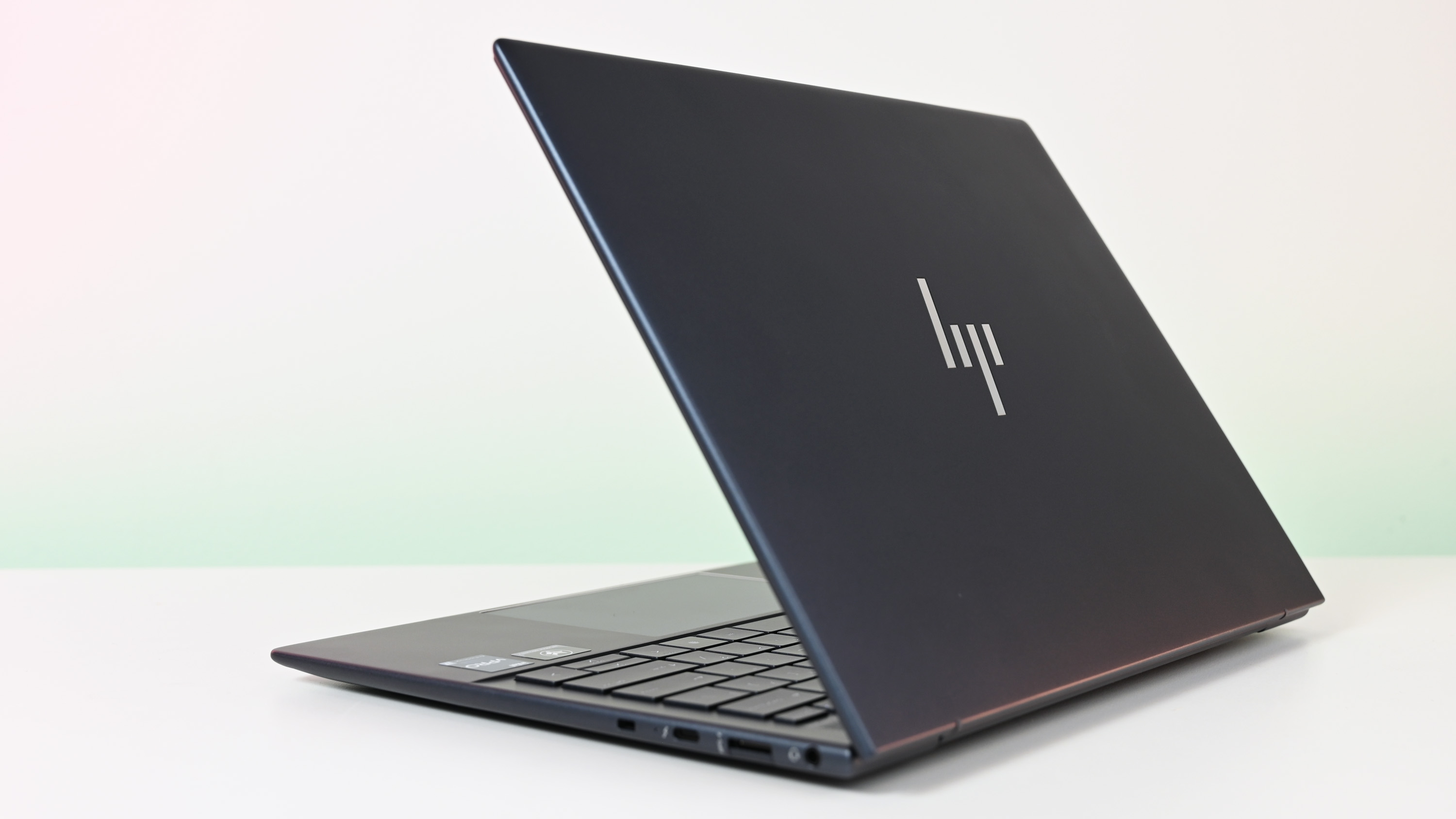
You should buy this if …
- Money is no object, and you want the best
- You prioritize a light laptop for daily travel
- You want 4G and 5G in an ultra-light but feature-packed laptop
- You want the best of laptop technology in one device
You should not buy this if …
- You’re on a fixed budget
- You don’t mind a heavier laptop
- You want a 2-in-1 form-factor
- You don’t like 3:2 display aspect
I won’t mince words. As you can tell from the title of this review, I love the HP Dragonfly G3 with 5G. I keep returning to it for my daily work, especially when traveling. The keyboard, touchpad, audio, and portability are just delightful, and no other laptop (save for the Dragonfly Folio G3) comes close to what this laptop offers.
The only downsides are the price and the battery life, which is pretty good, but not exceptional. But pricing has dropped since its release, with the base price now at $1,394 (versus $2,000+). So even maxed out at $2,100 is now a good bargain for all the hardware you are getting, including 5G.
Battery life is also good enough for me, but, like all things, I’d always take more. While keeping this laptop at 2.2 lbs, HP did what it could, though, and if I can push 7 to 8 hours, I’m a happy camper, especially with Type-C Fast Charge. But the Elite Dragonfly would even be better if it were close to 10 hours.
The bottom line is if you want the best of what a clamshell Windows laptop can be in late 2022, well, the HP Elite Dragonfly G3 is it, no question.
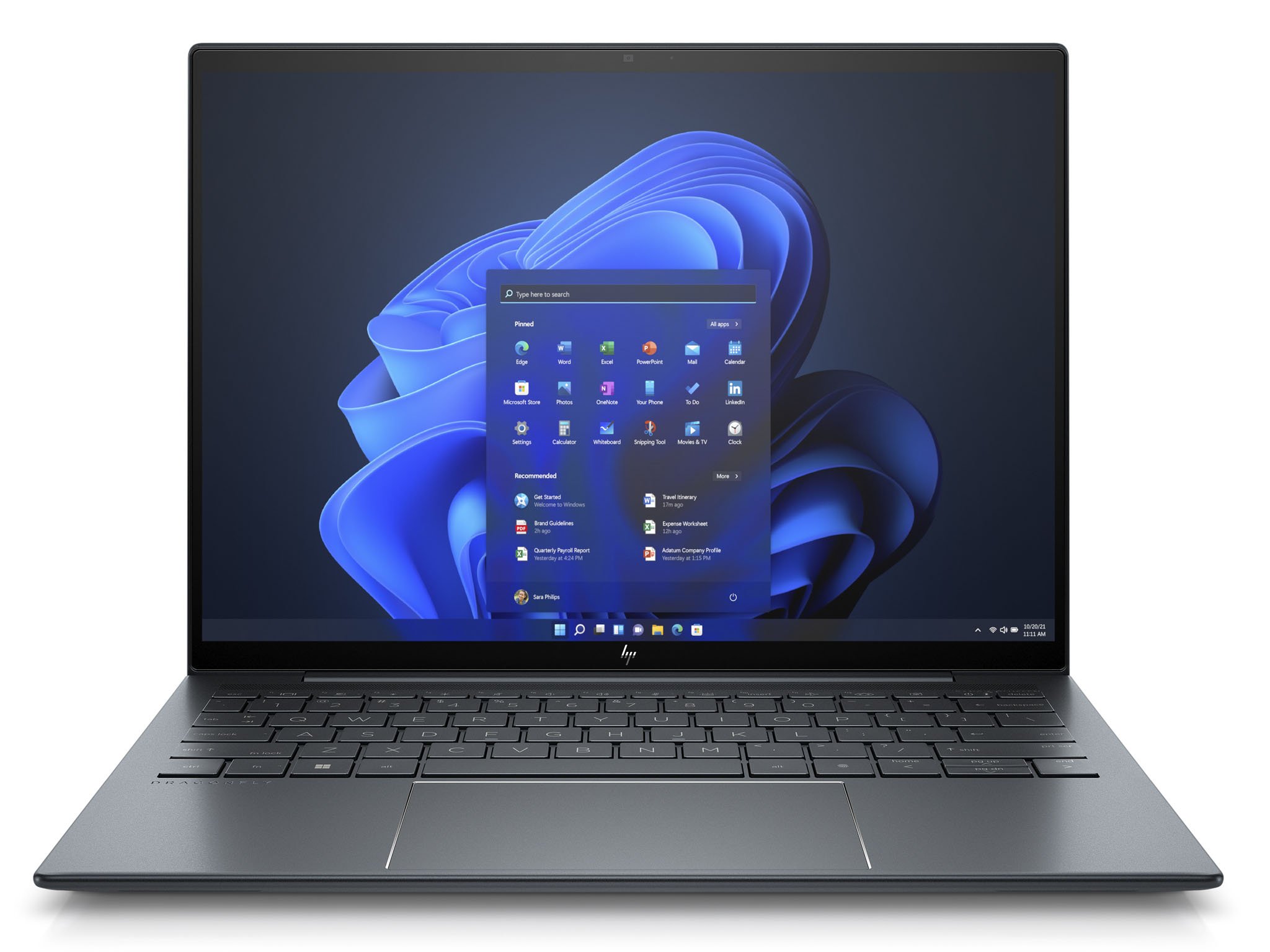
The new laptop on the block
The HP Elite Dragonfly G3 is the best business-class 13-inch laptop we have used. With optional 5G, a very good display, an excellent keyboard, touchpad, and speakers, it checks all the right boxes for the mobile professional who demands the best (and lightest at 2.2lbs) laptop around.

Daniel Rubino is the Editor-in-chief of Windows Central. He is also the head reviewer, podcast co-host, and analyst. He has been covering Microsoft since 2007 when this site was called WMExperts (and later Windows Phone Central). His interests include Windows, laptops, next-gen computing, and wearable tech. He has reviewed laptops for over 10 years and is particularly fond of 2-in-1 convertibles, Arm64 processors, new form factors, and thin-and-light PCs. Before all this tech stuff, he worked on a Ph.D. in linguistics, performed polysomnographs in NYC, and was a motion-picture operator for 17 years.
